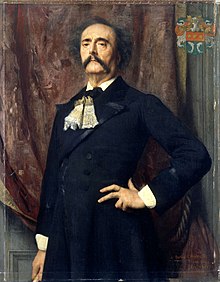Jules Barbey d'Aurevilly
Barbey d'Aurevilly | |
|---|---|
 Potret karya Émile Lévy, 1882. | |
| Lahir | Jules Amédée Barbey 2 November 1808 Saint-Sauveur-le-Vicomte, Normandy, Prancis |
| Meninggal | 23 April 1889 (umur 80) Paris, Prnacis |
| Makam | Saint-Sauveur-le-Vicomte |
| Pekerjaan | Novelis, esayis, kritikus |
| Periode | 1825–1889 |
| Aliran sastra | Realisme, Dekaden, "Dandyisme" |
| Karya terkenal | Les Diaboliques |
| Tanda tangan |  |
Jules-Amédée Barbey d'Aurevilly (2 November 1808 – 23 April 1889) adalah seorang novelis dan penulis cerpen asal Prancis. Ia gemar membuat cerita-cerita misteri. Ia mendapatkan pengaruh dari para penulis seperti Auguste Villiers de l'Isle-Adam, Henry James, Leon Bloy, dan Marcel Proust.
Lihat pula[sunting | sunting sumber]
Catatan[sunting | sunting sumber]
Referensi[sunting | sunting sumber]
Bacaan tambahan[sunting | sunting sumber]
- Beyham-Edwards, Matilda (1911). "French Author and Publisher Barbey d’Aurévilly and Trebutien." In: French Men, Women and Books. Chicago: A.C. McClurg and Co., pp. 95–104.
- Bradley, William Aspenwall (1910). "Barbey D'Aurevilly: A French Disciple of Walter Scott," The North American Review, Vol. 192, No. 659, pp. 473–485.
- Buckley, Thomas (1985). "The Priest or the Mob: Religious Violence in Three Novels of Barbey D'Aurevilly," Modern Language Studies, Vol. 15, No. 4, pp. 245–260.
- Chartier, Armand B. (1977). Barbey d'Aurevilly. Boston: Twayne Publishers.
- Eisenberg, Davina L. (1996). The Figure of the Dandy in Barbey d'Aurevilly's "Le Bonheur dans le Crime". New York: Peter Lang.
- France, Anatole (1922). "Barbey d’Aurevilly." In: On Life and Letters. London: John Lane, the Bodley Head, pp. 37–44.
- Gosse, Edmund (1905). "Barbey d’Aurevilly." In: French Profiles. London: William Heinemann, pp. 92–107.
- Griffiths, Richard (1966). The Reactionary Revolution: the Catholic Revival in French Literature, 1870–1914. London: Constable.
- Hansson, Laura Mohr (1899). "An Author on the Mystery of Woman: Barbey d'Aurevilly." In: We Women and our Authors. London: John Lane the Bodley Head, pp. 197–211.
- Jackson, Holbrook (1914)."The New Dandyism." In: The Eighteen Nineties. London: Grant Richards Ltd., pp. 105–116.
- Jamieson, T. John (1985). "Conservatism's Metaphysical Vision: Barbey d'Aurevilly on Joseph de Maistre," Modern Age, Vol. 29, No. 1, pp. 28–37.
- Lowrie, Joyce O. (1974). The Violent Mystique: Thematics of Retribution and Expiation in Balzac, Barbey d'Aurevilly, Bloy and Huysmans. Genève: Droz.
- Menczer, Béla (1962). "The Primacy of Imagination: From Diderot to Barbey d’Aurevilly." In: Catholic Political Thought. University of Notre Dame Press, pp. 49–57.
- Respaut, Michèle M. (1999). "The Doctor's Discourse: Emblems of Science, Sexual Fantasy, and Myth in Barbey d'Aurevilly's 'Le Bonheur dans le Crime'," The French Review, Vol. 73, No. 1, pp. 71–80.
- Rogers, B. G. (1967). The Novels and Stories of Barbey d'Aurevilly. Genève: Librairie Droz.
- Saltus, Edgar (1919). "Introduction." In: The Story without a Name. New York: Brentano's, pp. 5–23.
- Scott, Malcolm (1990). The Struggle for the Soul of the French Novel: French Catholic and Realist Novelists, 1850–1970. Washington, D.C.: Catholic University of America Press.
- Thiollet, Jean-Pierre (2006) & (2008). Barbey d'Aurevilly ou le Triomphe de l'Écriture, with texts by Bruno Bontempelli, Jean-Louis Christ, Eugen Drewermann and Denis Lensel. Paris: H & D Editions ISBN 2-914266-06-5; Carré d'Art : Barbey d'Aurevilly, Byron, Dali, Hallier, with texts by Anne-Élisabeth Blateau and François Roboth, Paris : Anagramme Ed. ISBN 978 2-35035-189-6
- Treherne, Philip (1912). "Barbey d'Aurevilly." In: Louis XVII and Other Papers. London: T. Fisher Unwin, pp. 133–146.
- Turquet-Milnes, G. (1913). "Barbey d'Aurevilly." In: The Influence of Baudelaire. London: Constable and Company, Ltd., pp. 135–145.
- Whibley, Charles (1897). "Barbey d’Aurevilly," The New Review, Vol. XVI, pp. 204–212 (rpt. in The Pageantry of Life. New York: Harper & Brothers, 1900, pp. 219–236.)
- Whitridge, Arnold (1922). "Barbey d’Aurevilly," The Cornhill Magazine, New Series, Vol. LIII, pp. 49–56.
Pranala luar[sunting | sunting sumber]
Wikisource Prancis memiliki teks asli yang berkaitan dengan artikel ini:
Wikimedia Commons memiliki media mengenai Jules Amédée Barbey d'Aurevilly.
- Karya Jules Barbey d'Aurevilly di Project Gutenberg
- Karya Jules Barbey d'Aurevilly di LibriVox (buku suara domain umum)

- Karya oleh/tentang Jules Barbey d'Aurevilly di Internet Archive (pencarian dioptimalkan untuk situs non-Beta)
- Works by Barbey d'Aurevilly, at Hathi Trust
- Jules-Amédée Barbey d’Aurevilly: Encyclopædia Britannica
- Jules-Amédée Barbey d’Aurevilly: Encyclopédie de L'Agora
 Chisholm, Hugh, ed. (1911). "Barbey d'Aurevilly, Jules Amédée". Encyclopædia Britannica (edisi ke-11). Cambridge University Press.
Chisholm, Hugh, ed. (1911). "Barbey d'Aurevilly, Jules Amédée". Encyclopædia Britannica (edisi ke-11). Cambridge University Press.
